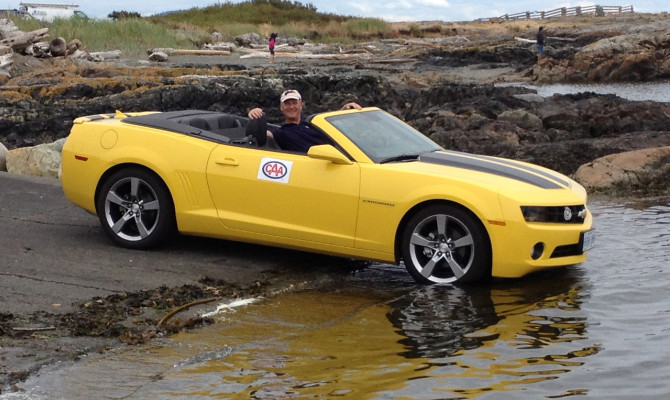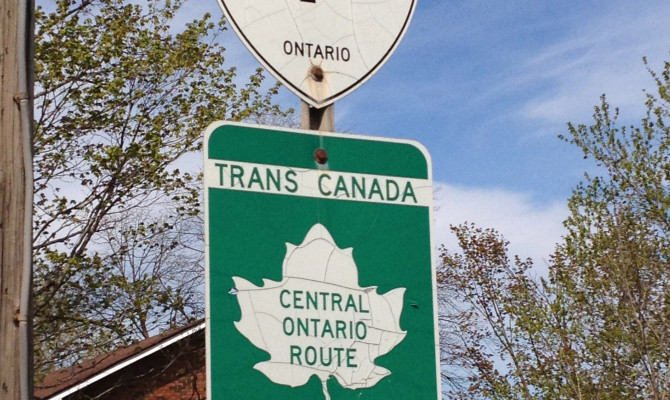Driving across Canada’s is on many people’s bucket list. Respected auto journalist Mark Richardson recalls his journey along Canada’s Road.
Canada’s a big country, second only to Russia in size. The highway that links her 10 provinces is 7,700 kilometres long, and I drove it in the summer of 2012 as research for my book, Canada’s Road.
Actually, that should be “research” with wagging quote fingers, because I’m always looking for a good road trip. Road trips are usually rushed affairs, hustling somewhere to enjoy the drive but with little time to stop and enjoy the scenery, but that summer, I slowed it all down and took 10 weeks for the drive. Much better.
It helped that my ride was a 2012 Chevy Camaro convertible, supplied for the trip by General Motors. It was loaned for three months; I put almost 27,000 kilometres on it, driving back and forth and twice across the country. The only thing I needed to change on it was the oil, and it didn’t put a tire turn wrong.
That year was the highway’s 50th anniversary, opened by Prime Minister John Diefenbaker on Sept. 3, 1962. I wanted to know if our Canadian icon is still important or just something now to brag about at international cocktail parties. There are lots of roads in the world; there are plenty of highways in Canada. What makes this one so special?
It was often a surprise for people to realize the TCH is only 50 years old – it’s taken for granted these days that there’s a road leading pretty much anywhere we want to go, and the road has always been there.
In fact, it’s been just a hundred years since the very first Canadian coast-to-coast road trip, driven by two guys in an open REO. Thomas Wilby and Jack Haney took 53 days to make it from Halifax to Victoria, but there were no roads in many parts of the country; when they reached North Bay, they had to put their car on trains and boats to cross the 1,700 km to Winnipeg, and in the Rockies, they had to detour through Washington state for a while.
The final road that made it possible to drive the width of Canada was not built until 1943, a stretch of gravel from Hearst to Geraldton in northern Ontario. It wasn’t the Trans-Canada, although it became a part of it when Diefenbaker eventually declared the highway open.
That was a proud day for Canada, despite both Newfoundland and New Brunswick boycotting the ceremony at B.C.’s Rogers Pass; the two provinces were holding out for more money to finish paving and smoothing the road. The TCH really wasn’t complete until 1970, and even now, billions of construction dollars in Quebec and Alberta are widening the road into four lanes to make it safer and more efficient.
The Trans-Canada is not always such an impersonal, high-speed highway. There are still many kilometres of two- and three-lane asphalt, winding through some of the most scenic areas of the country.
We have the Rogers Pass and the Kicking Horse Pass – impossible roads through high mountains considered impassable a few generations ago. We have the Fraser Canyon, clinging to the cliffside. We have the panoramic prairie, wide and swift. And we have the north shore of Lake Superior, built expressly as a scenic route to attract international tourists. On a clear day, there is nothing to surpass driving through a deep rock cut and dropping down through the green forest toward the shoreline of the broad lake, blue in summer, white in winter.
In Quebec, the TCH unfolds as an anonymous fast highway toward the Gaspe but encourages tourists to turn onto its original route, Hwy. 132, which runs close and parallel and follows the picturesque southern shore of the St. Lawrence. And in New Brunswick, the Trans-Canada sweeps drivers beside the Saint John River and toward the coast; it crosses into both Prince Edward Island and Nova Scotia and then up to Cape Breton, becoming for a few dozen kilometres a part of the Cabot Trail.
Then over on the ferry to Newfoundland, where the highway is the only link between the island’s west and east, just as it is on the other side of the country; in British Columbia, it’s the only paved link on Vancouver Island to Victoria, at the other end of another ferry.
The Trans-Canada Highway may not be the most efficient road in the world, and it still has a few dangerous twists and turns, but yes, it’s still important and it makes a great road trip, however long you’re able to take for the journey.
It’s a true Canadian compromise: a bit of everything for everyone – beauty, industry, and practicality – that pushes through our differences to link the country.
Mark Richardson’s book, Canada’s Road: A journey on the Trans-Canada Highway from St. John’s to Victoria, is published by the Dundurn Press.
Recent Comments
- { Enjoyed your Forest of Bowland in the BMW X5M, particularly the photo of the BMW in front of the main part of Stonyhurst College where... }
- { Bantam designed the Jeep, not Willy's or Ford. The American military gave the original Bantam prototype to Willys and Ford to copy. There is plenty... }
- { All Escalades come with a 6.2-lilter V8 engine that produces 420 horsepower. A six-speed automatic is the only transmission offered and drives the rear wheels.... }
- { Alexandra is an excellent journalist. }
Popular Posts
- Journey to a ‘Sparkling’ Luxury Okanagan Resort “Four lucky readers will put a Dodge Journey’s weekend-...
- The Need For Speed: Hike Those Highway Limits More than half of those polled believe the province sho...
- Drives-U-Crazy… Erratic drivers. An early morning drive from Kelowna to Vancouver is nor...
- Readers Respond: The Pros and Cons of Increasing B.C. Speed Limits Increasing the speed limits will only increase risk to...
- Honda CR-V Review: The Compact Crossover To Get Things Done The CRV is a very stylish and aerodynamic crossover veh...









